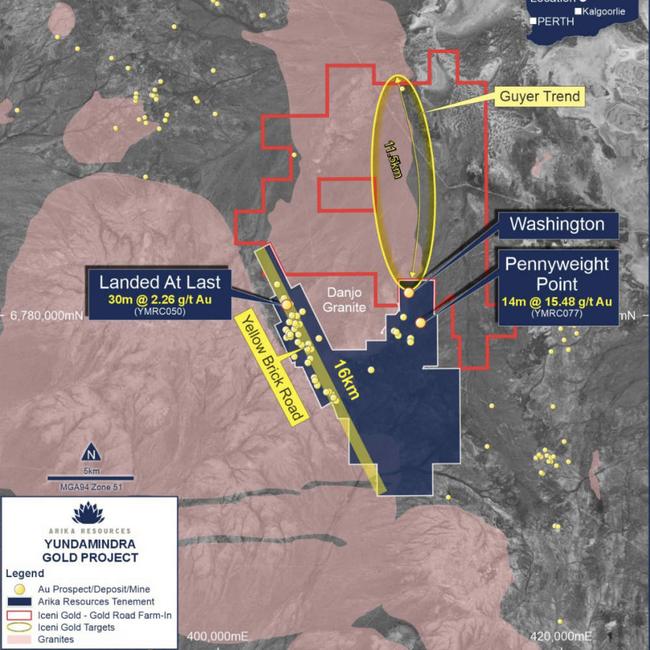Arika Resources flying at the F1-Fault, extends gold mineralisation
Arika Resources’ first diamond hole at the F1-Fault confirms untested potential of the F1 structure that strikes over 300m and extends to a depth of 80m.

Arika Resources’ first F1-Fault diamond hole extends gold mineralisation at depth
Results confirm untested potential of the F1 structure, which strikes over 300m and extends to a depth of 80m
Extensive pipeline of exploration and drilling underway or coming at Yundamindra project
Special Report: Arika Resources’ first ever diamond hole at the F1-Fault prospect within its Landed at Last trend has returned strong results that extend known gold mineralisation at depth.
Hole 25YMD003, the deepest to be drilled at the prospect to date, returned an assay of 14.8m grading 3.1g/t gold from a down-hole depth of 87m, including 2.15m at 5.49g/t from 90m and 2.25m at 9.76g/t from 99m.
Notably, it extends gold mineralisation by 40m downdip from the nearest historical drill hole.
The intersection sits 200m west of the ‘main’ Landed at Last trend within the Yundamindra project, where recent drilling by Arika Resources (ASX:ARI) returned a series of spectacular results and extended its strike to over 800m.It confirms the significant untested potential of the F1 structure, which currently has a strike length of over 300m and extends to a depth of at least 80m from surface.
“We are very encouraged by the assay results received from our first-ever diamond drilling into the F1-Fault Prospect at Landed at Last,” managing director Justin Barton said.
“Assays have returned a thick intercept of strong gold mineralisation including two high-grade intervals which have extended the known mineralisation at depth.
“Obtaining diamond drill core is a very valuable asset for our technical team in order to advance our understanding of the host rock lithologies and identify key structural controls that host the mineralisation at the F1-Fault and broader Landed at Last prospect.
“This information will enhance our ability to target mineralised extensions along strike and at depth, as well as to help prioritise the vast pipeline of targets identified from the geophysics and geochemical reviews completed recently.
“The F1-Fault – which remains open along strike and at depth and already extends over a strike length of 300m and to a depth of at least 80m down-dip – is a highly mineralised structure cross-cutting the Landed at Last lode.”

Yundamindra project
The Yundamindra project within the historical production centre of Laverton, WA, is immediately along strike of the recently announced $44m Guyer joint venture between Iceni Gold (ASX:ICL) and Gold Road Resources (ASX:GOR).
It includes the Landed at Last trend that sits on the Western Limb of the project towards the northern end of the ‘Yellow Brick Road’ – a highly mineralised >10km long structural corridor with numerous high-grade historical workings developed on multiple parallel and cross-cutting structures.
This corridor has received only limited shallow historical drilling around the areas of historical workings and remains largely untested below 50m vertical depth while the ore hosting structures between the old workings remain unexplored.
The F1-Fault is one of a series of second order linking structures which cross-cut the Landed at Last lode. Several similar parallel structures, the F2 and F3 Faults, remain untested despite each hosting a number of associated historical workings.
Recent assessment of surface geochemistry has identified numerous peak gold-in-soil anomalies well away from the historical workings and previous drilling – all of which are considered priority targets.
ARI’s most recent drilling consisted of a single diamond hole at the F1-Fault to test for depth extensions beyond the known limits of the near-surface mineralisation, confirm host rock lithologies, identify key structural controls, provide insights into geotechnical aspects for future mining studies, and identify potential multi-element alteration signatures.
Next steps
Arika is currently processing diamond drill core from two holes completed at the Pennyweight Point prospect.
It is also incorporating results from its recent review of historical geochemistry at Yundamindra into its existing geophysical/structural targets.
An ultra-detailed drone supported aeromagnetic survey is scheduled to begin in the coming weeks over the southern half of Yundamindra to further refine target selection prior to restarting drilling in the coming weeks.
Over at the Kookynie project, ARI is carrying out a detailed review that has already identified a pipeline of multiple new, high-priority gold targets.
It also plans to carry out surface geochemical soil surveys at a number of key prospects in the coming weeks to prioritise targets for drilling during Q2 or Q3 2025.
This article was developed in collaboration with Arika Resources, a Stockhead advertiser at the time of publishing.
This article does not constitute financial product advice. You should consider obtaining independent advice before making any financial decisions.


